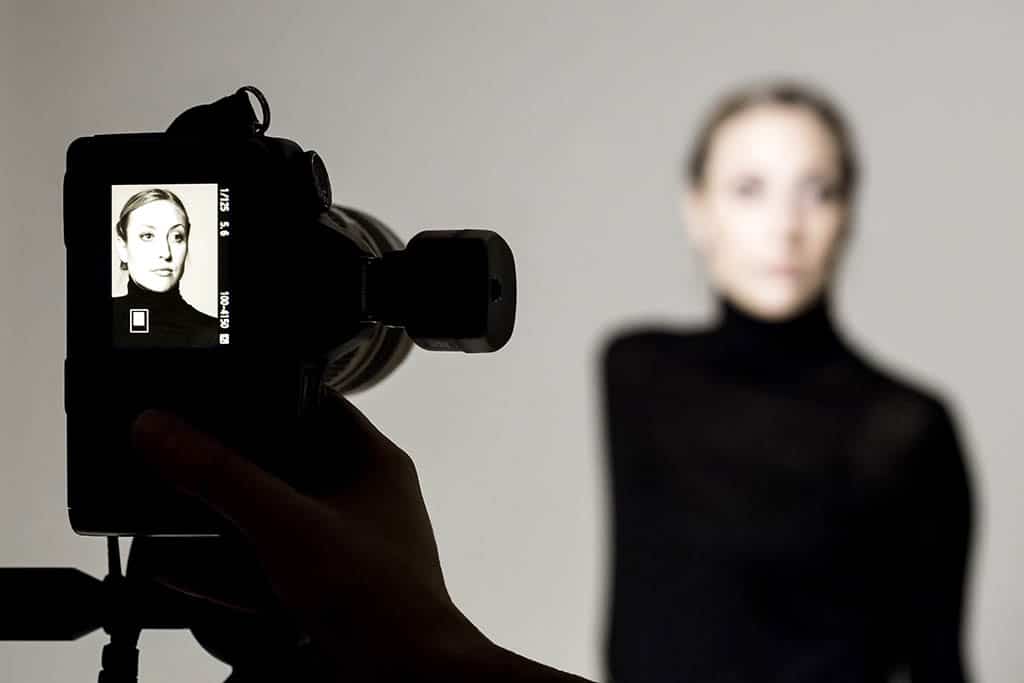I recently went salsa dancing again at one of my favorite places. The music always comes from the same DJ and the rooms have been the same for years. I bump into familiar faces, but there are also new ones every time. This mixture is what makes salsa so appealing: the setting is always the same, but the dance experience is not.
It’s the same with portrait photography. I can use technology, light and camera as usual – and yet the result is not 100% predictable. Because every shoot is a new encounter. Every dance is a new encounter.

Wishes and expectations
Every portrait photo has a purpose: for a profile picture, an annual report, a job application – or simply for yourself. Some customers know exactly what they want. Others prefer to be inspired. I adapt to the model and take time before the planned shoot to understand their wishes and prepare myself well.
They often show me examples, tell me about ideas – like a customer who wanted to bring flowers into the picture. We looked together at how that might work, but in the end we decided against it. Because not every accessory fits into every picture.
I like to work in a reduced way and concentrate on the essentials – this makes the photo timeless. The important thing is that we start with clear ideas and a framework of what is possible. This saves time and avoids disappointment.

How to create closeness in front of the camera
Good portraits are always (!) created together. I give impulses, the model reacts. She makes a movement and inspires me to take a different perspective. This results in a game – sometimes reserved, sometimes bold. I suggest poses or props, the model tries them out. A chair can play many roles. Or a different background awakens new ideas.
Time pressure is the worst enemy of a good portrait shoot. I prefer to take the time needed to make the model feel comfortable. Because good pictures can only be taken without stress.

Talking helps – even with portrait photography
During the shoot, I openly say what I see in the picture and how it looks to me when I look through the camera. This creates trust. If possible, we look at the pictures directly on the screen. That way we can check together: Is the direction right? Or do we want more variations?
When a make-up artist is involved, she brings in another perspective. More eyes see more – and often more possibilities.

The room works with
The surroundings also count: Is it warm or cold? Is there music, snacks, places to retreat to? What does the light look like? What mood does the technology create? This doesn’t just mean whether the technology looks well-maintained or shabby, but what characteristics it has. Artificial light, i.e. continuous light, appears warmer, more intimate and less technical than flash light, especially when the generators beep after charging. With flash, there is more of a feeling of “shooting” photos. Even the shutter sound of the camera changes the feeling of taking pictures. I pay attention to these details – they make a difference.
When technology alone is not enough
Some things I can’t control: the weather, the journey, the form of the day. What counts most is your inner attitude. If you are unhappy with yourself, it shows in the picture. The outside is always a part of the inside. Wrinkles in the skin, tired eyes or drooping corners of the mouth can’t just be quickly retouched away. I can control a lot with light, perspective and encouraging words – but I can’t hide everything. Good portraits show personality. And that comes from within.

How dancing has shaped me as a photographer
Dancing salsa has made me realize that: Even with the same figures, every dance has a different energy. Music, lighting mood, partner – it all plays a part.
Photography works in a similar way. It’s the journey that counts, not just the result. Good photos are created when both parties contribute their ideas – without having to stick to them. Something new is created together. The goal is not to be perfect, but to be present.
How can this succeed? It starts with both parties consciously recognizing and questioning their expectations. The photographer can create the framework conditions for this: With his communication style, his interactions and the ambience. This playfulness is important in dancing and photography. As a dancer, I can make sure that my dance partner feels comfortable, is not overwhelmed or underchallenged and looks good at the same time. I can also have a bit of fun, challenge them and push them to their limits without exceeding them. This creates lightness – just like dancing.
Conclusion
From the outside, portrait photography is technology. In reality, it is a relationship, communication and experience. No two shoots are the same.
Dancing means being in the moment. The shoot itself is a moment. But the photo as a result remains. It can be shared, have a lasting effect, awaken memories. That’s why good portrait photography has its value. When the client says to me: “You can see that you enjoy your work”, then I know it was a good shoot.
You might also be interested in these articles
Preparing for a portrait shoot – simple and effective
The 7 most important aspects for a professional business portrait





